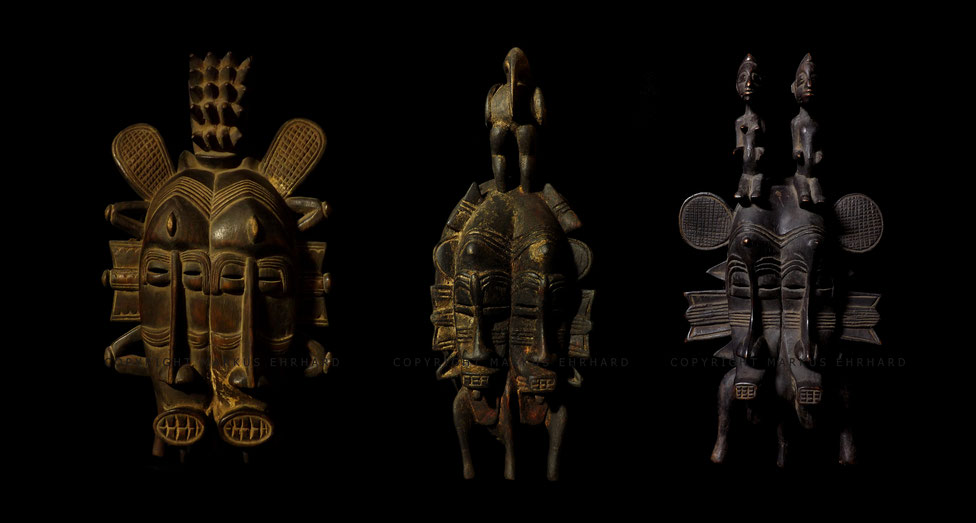
In about one of ten Kpelié masks you will find the double faced mask, Yêchikpleyégué in Senari. In literature you can read, that this genre does show bisexuality. But the Senufo do not differentiate or discriminate between sexual orientation. Karl-Heinz Krieg told me, that this genre is made by intelligent Senufo carvers. Only a smart carver can deal to create two identical faces. This interpretation depends on the region. It is noticeable, that many of the doublefaced Kpelié show a Tugubele couple or a single female Tugubele spirit on top.
It is for sure to say, that the double faced mask is dancing on the event to welcome twins. Everyone in the village can see the mask. The dancing double faced Kpelié is a symbol of the celebration and protection of the twins life.
It is a challenge for a Koulé to carve two identical faces side by side and for sure it demands a smart carver to do this. So Karl-Heinz Krieg's explanation is logic. It also demands a lot, to carve identical Tugubele couple, where is there is differenciation between a male a female statue. The Kpelié alsways is a male character, so both faces have to be absolutely identical.
Doh Soro, a Koulé from Djemtene, who is famous for his maternité statues, rarely carved masks. So his double faced mask is the only one known made by his hands.
There are certain Koulés especially famous for the double faced mask. Althought Yalourga Soro, a Koulé from Ganaoni, was eminent for this genre, there are no single faced masks known. Yalourga had problems to carve an identical Tugubele couple. But his small masks are delicate and his faces are absolutely identical.
Nono Koné, a Koulé from Tiogo, who died 1970, did carve this classic doublefaced Kpelié with the Tugubele couple on top. Their meaning is a matter of conjecture and is not clarified.
Left: Yêchikpleyégué, double faced Kpelié mask, carved by Doh Soro, Koulé from Djemtene, region of Korhogo.
34,0 x 18,0 x 9,5 cm, wood.
Literature:
- Wenn Neuordnung Ordnung schafft, Markus Ehrhard, pages 116 - 117.
Middle: Yêchikpleyégué, doublefaced Kpelié mask, carved by Yalourga Soro, Ganaoni. Early work.
32,5 x 11,5 x 5,0 cm, wood.
Literature:
- Wenn Neuordnung Ordnung schafft, Markus Ehrhard, pages 144 - 145.
Right: Yêchikpleyégué (doublefaced Kpelié) mask, carved by Nono Koné, Koulé from Tiogo.
34,5x 18,0 x 9,0 cm, wood. Collected by Karl-Heinz Krieg. Time of origin around 1950.
Literature:
- Wenn Brauch Gebrauch beeinflusst, Markus Ehrhard, pages 118 - 119.
- Wenn Urform Form bestimmt, Markus Ehrhard, pages 24 - 25, 40 - 41.
Copyright content and images by Markus Ehrhard

